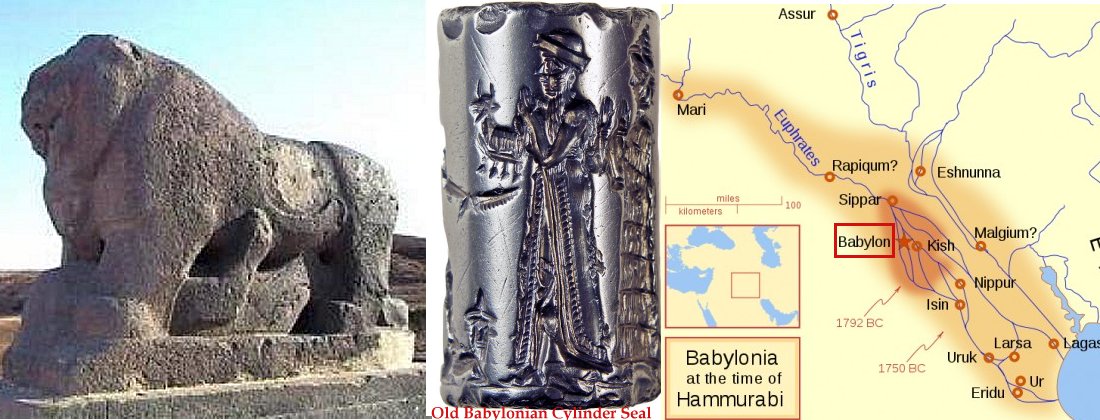Glory And Fall Of Babylon Dedicated To The Cult Of Marduk
– More than a thousand of years, Babylon (in Akkadian “Babilim” means “Gate of God”) was the symbol of power, greatness and destruction.
For over one thousand of years, Babylon was also the center of worship of the god Marduk.

The ruins of the city (the canal system, gardens, walls and the remains of some temples) are located approximately 80 kilometers south of Baghdad on the east bank of the Euphrates River.One of the most prominent buildings of Babylon (today only its ruins) was the ziggurat Etemenanki, which means “temple of the foundation of heaven and earth”).
The structure – initially Etemenanki was 91 high – was dedicated to Marduk in the city of Babylon of the 6th century BC Neo-Babylonian dynasty.
Etemenanki may have been an inspiration for the biblical story of the Tower of Babel.
In ancient times, Babylon was considered almost the “center of the world”. Even, Alexander the Great was charmed by its beauty and power. One day, Babylon became the capital of his gigantic empire and became a place where he died.
In 331 BC, Alexander the Great captured Babylon and ordered repairs to the Etemenanki but he noticed no progress in repairs when he returned to Babylon in 323 BC. On Alexander’s orders his army destroyed the entire Etemenanki to prepare a final rebuilding.
It never happened, Alexander the Great died in Babylon.
For the ancient people, Babylon was the “sacred city” dedicated to the cult of Marduk, who had there his temple and a golden statue, which unfortunately was looted several times by attacking Hittites, Elamites, Assyrians.First historical records that mention Babylon date back to c. 23rd century BC and the reign of Sargon of Akkad and c. 1900 BC, Babylon was occupied by Amorites.
However, the most famous ruler of Babylon was Hammurabi, the sixth king of the First Babylonian Dynasty, reigning from 1792 BC to 1750 BC and famous for his code, known as the Code of Hammurabi.
Hammurabi made Babylon the center of his kingdom, as the capital with flourishing trade and economy, and the powerful center of worship.
Babylon lost its independence many times and was destroyed by its conquerors. Somehow, the city could still recover and be stronger and stronger, with the help of Nebuchadnezzar II, a Chaldean king of the Neo-Babylonian Empire, who reigned c. 605 BC – c. 562 BC and constructed the Hanging Gardens of Babylon but unfortunately, also destroyed the temple of Jerusalem.
One day Babylon’s glorious times had to end.
In 539 BC, the Neo-Babylonian Empire fell to Cyrus the Great, king of Persia but under Persian rule the town still flourished; it became a center of learning and science. In Achaemenid Persia, the ancient Babylonian arts of astronomy and mathematics were revitalized, and Babylonian scholars completed maps of constellations.
The city became the administrative capital of the Persian Empire and remained very important for more than two centuries.
The Persian kings made several attempts to protect religious ceremonies in the city of Babylon but, the Babylonian people protested against the Persian dominance.
Walls of Babylon and the ziggurat Etemenanki were destroyed and the golden statue of Marduk – disapppeared.
Then, Alexander the Great became the ruler of Babylon, who as we mentioned earlier, tried to restore the city’s glory. He never did it because he died in Babylon.
According to a tablet dated 275 BC, the inhabitants of Babylon were deported to Seleucia, and thus, Babylon became insignificant as a city.
Written by A. Sutherland AncientPages.com Staff Writer
Copyright © AncientPages.com All rights reserved. This material may not be published, broadcast, rewritten or redistributed in whole or part without the express written permission of AncientPages.com



 Creators of mankind
Creators of mankind Description of “Tall white aliens”
Description of “Tall white aliens” Where they came from?
Where they came from? About hostile civilizations
About hostile civilizations The war for the Earth
The war for the Earth “Tall white aliens” about eternal life
“Tall white aliens” about eternal life Video: “Nordic aliens”
Video: “Nordic aliens” Aliens
Aliens Alien encounters
Alien encounters The aliens base
The aliens base UFO
UFO Technology UFO
Technology UFO Underground civilization
Underground civilization Ancient alien artifacts
Ancient alien artifacts Military and UFO
Military and UFO Mysteries and hypotheses
Mysteries and hypotheses Scientific facts
Scientific facts


















